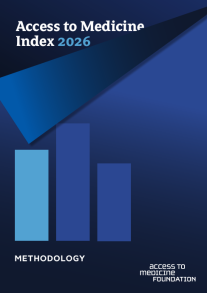Methodology for the 2026 Access to Medicine Index
Date
09 October 2025
Now available for download, the 2026 Index Methodology outlines the scopes and analytical framework – including priority topics and indicators – that will be used in the 2026 Access to Medicine Index, the tenth iteration of this assessment. To ensure the 2026 Index remains a rigorous tool for assessing company performance and driving meaningful change, the methodology has been refined following an extensive internal review alongside consultations with over 80 global health stakeholders and subject matter experts.
The Foundation uses strict standards for deciding when to merge or remove a metric within the analytical framework, with some of the key changes set out below. The scopes of the 2026 Index, and all indicators, including descriptions and rationales for changes, are included in the 2026 Index Methodology.
The methodology at a glance
Policies and behaviour will be analysed for the same 20 research-based pharmaceutical companies, across the same 113 low- and middle-income countries and 8 product types as in the 2024 Index. Company behaviour will be assessed using 29 indicators (32 in 2024) organised in the same three Technical Areas – Governance of Access, Research & Development and Product Delivery – which are divided into the same 15 priority topics.
Changes to the scopes and analytical framework include:
Expanded disease scope (84 in 2026; 81 in 2024): Mpox (monkeypox) and Noma disease have been added to the disease scope. Kidney cancer has also been added, although this does not impact the total number of diseases in scope, as all cancer types included are grouped under one umbrella disease. Two pathogens, Campylobacter spp. (fluoroquinolone-resistant) and Helicobacter pylori (clarithromycin-resistant), have been removed, while Group A Streptococci (macrolide-resistant), Group B Streptococci (penicillin-resistant) and non-typhoidal Salmonella (fluoroquinolone-resistant) have been added.
Updated definition of inclusive business models (IBMs): These refinements aim to recognise the IBMs that are demonstrably delivering sustainable access and to guide companies in pursuing effective implementation.
Building on ‘patient reach’: Measuring and reporting patient reach was introduced as a priority topic with a standalone patient reach indicator in the last iteration of the Index. The indicator and assessment parameters have been updated to provide clearer expectations and guidance for companies.
Other areas of sharpened focus: The methodology looks more closely at how companies ensure uninterrupted supply and support local availability, and how they contribute to broader access by strengthening surrounding ecosystems — such as through capacity building initiatives, partnerships with governments and NGOs, and opportunities for local manufacturing or clinical trials (CTs).

